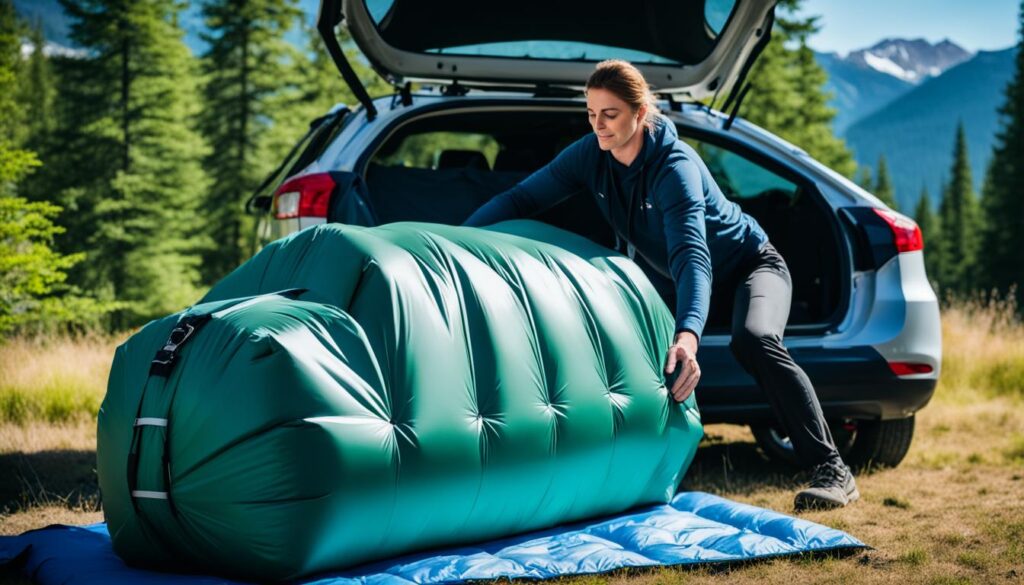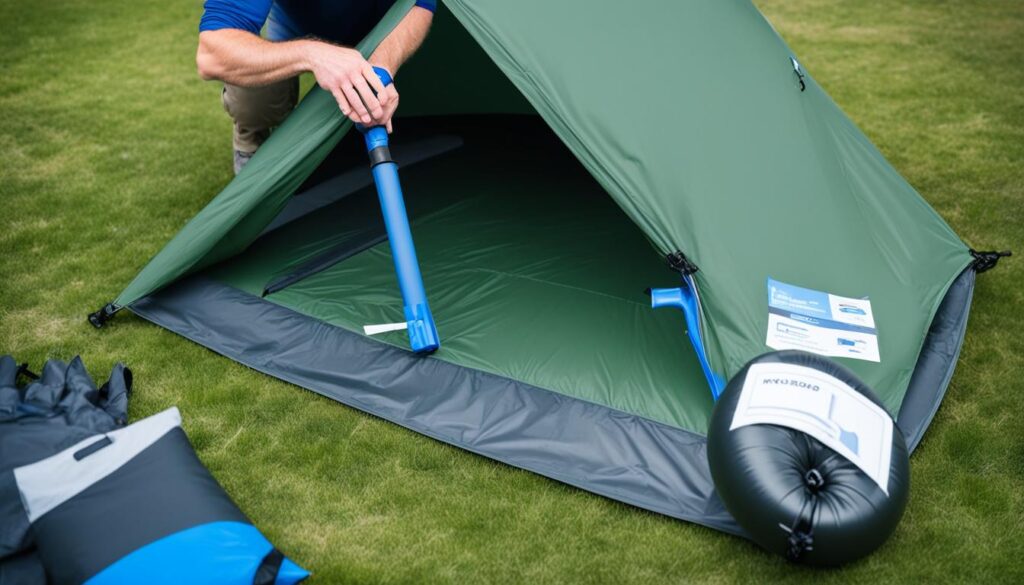
Imagine this: You’re out in the wilderness, surrounded by tall trees and breathtaking nature. The sun is shining, and the air is filled with a refreshing scent of adventure. You unpack your inflatable tent, excitedly anticipating a cozy and comfortable night under the stars.
But as you begin to pack up your tent after a memorable camping trip, frustration starts to creep in. You struggle to fold and store the tent efficiently, wasting precious time and energy. The once delightful experience turns into a tedious chore.
Does this sound familiar? If so, you’re not alone. Packing and storing inflatable tents can be a challenge without the right knowledge and techniques. But fear not! In this article, we will share expert tips and tricks to help you pack and store your inflatable tent with ease.
Key Takeaways:
- Proper packing and storage techniques are essential for efficient management of inflatable tents.
- By following expert tips, you can avoid frustration and save time when packing and storing your tent.
- Consider factors such as size, layout, and brand quality when choosing an inflatable tent.
- Regular maintenance, cleaning, and reproofing are crucial for the longevity of your tent.
- By practicing proper folding and storing techniques, you can protect your tent and maximize storage space.
Types of Inflatable Tents
When it comes to choosing an inflatable tent, there are several different types available on the market. Each type is designed to cater to specific camping needs and preferences. Let’s explore the various types of inflatable tents:
Inflatable Dome Tent: The inflatable dome tent is a popular choice due to its simple and compact design. These tents are easy to set up and have a stable structure, making them ideal for weekend camping trips or festivals.
Inflatable Tunnel Tent: If you’re looking for more living space and versatility, the inflatable tunnel tent is a great option. This type of tent allows you to divide multiple spaces within the tent, making it ideal for families or larger groups.
Intermediate Inflatable Center Pole Tent: The intermediate inflatable center pole tent combines the features of an inflatable tube and shelter. These tents are often used at trade shows or events where visibility is essential. However, they may not be as stable as other types and are not recommended for extreme weather conditions.
Custom Inflatable Tents: For specialized camping experiences such as backpacking or mountaineering, custom inflatable tents are available. These tents are designed to meet specific requirements and provide enhanced durability, portability, and functionality.
Each type of inflatable tent offers unique features and benefits, allowing you to choose the one that best suits your needs and preferences. Whether you’re a weekend camper, a family adventurer, or an outdoor enthusiast, there’s an inflatable tent out there for you.
Stay tuned for the next section where we’ll explore tips for setting up your inflatable tent!
Tips for Setting Up Your Inflatable Tent
Proper setup of your inflatable tent is essential for a comfortable camping experience. Follow these tips to ensure a hassle-free and successful setup:
- Choose the right location: Before setting up your inflatable tent, carefully consider the terrain and surroundings. Look for a flat and level area with no rocks or sharp objects that could potentially damage the tent.
- Lay out the groundsheet: Place a groundsheet or tarp underneath your tent to protect the bottom from moisture, dirt, and punctures. This added layer will help prolong the lifespan of your tent.
- Familiarize yourself with the setup process: Read the instruction manual provided with your inflatable tent and familiarize yourself with the setup process before heading out. This will help you save time and avoid any confusion on-site.
- Inflate the tent chambers gradually: When inflating your tent, start with the main chamber and then gradually inflate the remaining chambers. This ensures that the pressure is evenly distributed and reduces the risk of seams tearing.
- Check for proper alignment and tension: Once your tent is inflated, check if it is properly aligned and tensioned. Adjust the guy lines and stakes as necessary to ensure a taut and stable structure.
- Secure the guy lines: Utilize the guy lines provided with your tent to enhance stability in windy conditions. Attach them to nearby trees or use stakes to secure them firmly into the ground.
- Utilize internal storage pockets: Take advantage of the internal storage pockets in your inflatable tent to keep your gear organized and easily accessible.
- Ventilate the tent properly: Proper ventilation is crucial to reduce condensation inside the tent. Open mesh windows or vents to allow fresh air to circulate and prevent moisture buildup.
- Secure the rainfly and groundsheet: If your tent comes with a rainfly and removable groundsheet, make sure they are properly secured to provide extra protection against rain and ground moisture.
- Practice Leave No Trace principles: When setting up your inflatable tent, be mindful of the environment. Follow Leave No Trace principles by minimizing your impact, packing out all trash, and leaving your campsite as you found it.
By following these tips, you can ensure a successful and enjoyable camping experience with your inflatable tent. Take your time, pay attention to detail, and enjoy the great outdoors!

Tips for Efficiently Packing Your Inflatable Tent
Efficiently packing your inflatable tent is crucial for easy storage and transportation. By following these tips and practicing the packing process, you can ensure that your inflatable tent is packed efficiently for future use.
Familiarize Yourself with the Tent
Before packing your inflatable tent, take some time to familiarize yourself with its layout and components. This will make the packing process easier and quicker.
Choose a Suitable Venue
Find a spacious and clean area where you can pack your tent without any obstructions. This will allow you to move freely and ensure that the tent is not damaged during the packing process.
Lay Out the Tent for Inspection
Before packing, lay out the tent to inspect it for any damages or signs of wear. This will help you identify any issues that need to be addressed before storing the tent.
Inflate the Tent Properly
Ensure that the tent is fully inflated before packing it. This will help maintain its shape and prevent any creases or folds that can cause damage during storage.
Secure the Tent to the Ground
If possible, secure the tent to the ground using tent stakes or weights. This will prevent the tent from moving or shifting while you pack it, making the process easier and more efficient.
Check for Stability
Once the tent is inflated and secured, check for stability. Make sure that all the chambers are properly inflated and that the tent is standing firmly without any wobbling.
Deflate the Tent Completely
Before packing, deflate the tent completely by opening all the valves and allowing the air to escape. This will make it easier to fold and roll the tent.
Fold and Roll the Tent Tightly
Start folding the tent from one end, making sure to remove any excess air. Then roll it tightly, pressing out any remaining air pockets. This will help reduce the size of the tent and make it easier to pack.
Store the Tent Properly
Finally, store your inflatable tent in a dry and clean container or bag. This will protect it from moisture, dust, and pests. Ensure that the storage container is large enough to accommodate the folded tent without causing any unnecessary creases.
| Tips for Efficient Packing |
|---|
| Familiarize yourself with the tent |
| Choose a suitable venue |
| Lay out the tent for inspection |
| Inflate the tent properly |
| Secure the tent to the ground |
| Check for stability |
| Deflate the tent completely |
| Fold and roll the tent tightly |
| Store the tent properly |
Maintenance and Care for Your Inflatable Tent
Proper maintenance and care are essential for ensuring the longevity and performance of your inflatable tent. By following these tips, you can keep your tent in good condition and enjoy many outdoor adventures.
Inflatable Tent Maintenance:
- Cleaning the Tent: After each use, it’s important to clean your tent to remove dirt, debris, and any stains. Use a mild soap and water solution or a tent-specific cleaner. Gently scrub the surface of the tent with a soft brush or sponge, then rinse thoroughly. Avoid using harsh chemicals or abrasive materials that can damage the fabric.
- Drying the Tent: Before storing your tent, make sure it is completely dry. Hang it up or spread it out in a well-ventilated area away from direct sunlight. This will prevent mold and mildew growth and ensure the tent’s waterproofing remains intact.
- Checking for Damages: Regularly inspect your tent for any damages such as punctures, tears, or worn-out seams. Repair any issues promptly using a tent repair kit or patch. This will prevent further damage and extend the lifespan of your tent.
Proper Storage:
- Storing the Tent: After cleaning and drying the tent, store it in a dry and clean container or bag. Avoid folding or storing the tent when it’s still damp, as this can lead to mildew and unpleasant odors.
- Inflating and Inspecting the Tent: Periodically inflate your tent to check for any air leaks or structural issues. Pay attention to the seams, valves, and chambers. If you notice any problems, address them promptly to maintain the tent’s performance.
- Following Manufacturer’s Instructions: Every inflatable tent comes with specific maintenance and care instructions from the manufacturer. It’s important to follow these guidelines to ensure that you’re taking the best care of your tent and maximizing its lifespan.
By properly maintaining and caring for your inflatable tent, you can enjoy years of outdoor adventures with the peace of mind that your shelter is in optimal condition.

Cleaning and Reproofing Your Inflatable Tent
Regular cleaning and reproofing are essential for maintaining the performance and lifespan of your inflatable tent. By following these steps, you can ensure that your tent remains water-resistant and in optimal condition for your outdoor adventures.
Cleaning Your Tent
To start the cleaning process, gather the necessary supplies:
- Clean water
- Mild soap or specialized tent cleaner
- Soft-bristle brush or sponge
Begin by removing stakes and poles from the tent. This will make the cleaning process easier and prevent accidental damage to the tent material.
Next, use a soft-bristle brush or sponge to brush off any debris or dirt from the tent’s surface. Pay close attention to any stains or stubborn spots that require spot cleaning.
If necessary, prepare a cleaning solution by mixing clean water with a mild soap or specialized tent cleaner. Follow the product instructions for the correct dilution ratio.
Spot clean any stains by gently scrubbing the affected areas with the cleaning solution and a soft-bristle brush. Make sure to thoroughly rinse off the soap or cleaner after spot cleaning.
After spot cleaning, wash the entire tent by applying the cleaning solution to the surface. Gently scrub the tent using a soft-bristle brush or sponge to remove any dirt or grime.
Rinse the tent thoroughly with clean water to remove any residue from the cleaning solution. Ensure that all soap or cleaner is completely rinsed off.
Once cleaned, allow the tent to dry completely before proceeding to the reproofing process.
Reproofing Your Tent
Reproofing your tent helps restore its water resistance and protect it from the elements. Follow these steps to reproof your inflatable tent:
- Choose a suitable tent waterproofing product. Check the manufacturer’s instructions or consult with a camping gear specialist for the best product for your specific tent.
- Apply the reproofing product to the tent, paying close attention to seams and zippers, which are common areas for water leakage.
- Ensure that the tent is completely dry before applying the reproofing product. Moisture can affect the effectiveness of the product.
- Allow the reproofing product to dry completely as per the manufacturer’s instructions.
- Test the tent for waterproofing by spraying water on its surface. If the water beads up and rolls off, the reproofing process was successful. If the water seeps into the fabric, consider reapplying the waterproofing product.
Regularly cleaning and reproofing your inflatable tent will help maintain its water resistance and extend its lifespan, ensuring that you have a reliable shelter for your outdoor adventures.
Folding and Storing Your Inflatable Tent
Properly folding and storing your inflatable tent is crucial for maintaining its condition and maximizing available space. By following these tips, you can ensure that your tent is safely packed away and ready for your next adventure.
- Allow time to air out the tent: Before folding and storing your inflatable tent, make sure to give it some time to air out. This will help remove any moisture and prevent mold or mildew from forming.
- Ensure the tent is clean and dry: Before folding, check that your tent is clean and completely dry. Remove any dirt or debris and wipe down any wet surfaces to prevent damage and mildew growth.
- Take pre-packing precautions: When preparing to fold your tent, take precautions such as removing stakes, wiping down poles, and securing loose straps or cords. This will help prevent damage and make the folding process easier.
- Choose a suitable storage location: Find a suitable storage location for your inflatable tent, such as a dry and cool area. Avoid areas that are prone to extreme temperature changes, direct sunlight, or excessive moisture.
- Ensure proper ventilation: When storing your tent, it’s important to provide proper ventilation to prevent the buildup of moisture and odors. Consider using a breathable storage bag or leaving openings in the storage container.
- Avoid direct sunlight: Direct sunlight can cause the fabric of your inflatable tent to fade and deteriorate over time. Store your tent in a shaded area or use a UV-resistant cover to protect it from the sun’s rays.
- Use a storage bag: Invest in a quality storage bag specifically designed for inflatable tents. These bags typically have enough space to accommodate your folded tent and provide additional protection.
- Store poles separately: To prevent potential damage to your tent or poles, store them separately. This will minimize the risk of punctures or bending during storage.
- Label and organize: Keep your storage area tidy by labeling and organizing your inflatable tent and its accessories. This will make it easier to locate and retrieve your tent when needed.
- Regular check-ups: Periodically check your stored tent for any signs of damage, moisture, or pests. Address any issues promptly to prevent further deterioration or infestations.
- Protect against pests: Take measures to protect your inflatable tent from pests such as insects or rodents. Consider using pest repellents or storing your tent in a sealed container to prevent unwanted visitors.
By following these folding and storage tips, you can ensure that your inflatable tent remains in good condition and ready for your next outdoor expedition.
Conclusion
Efficient packing and storage of your inflatable tent are crucial for its durability and your overall camping experience. By following the tips and techniques outlined in this guide, you can ensure that your inflatable tent is packed and stored in the most efficient way possible.
When choosing an inflatable tent, consider factors such as size, layout, weather resistance, and brand quality. These factors will contribute to the ease of setup, comfort, and longevity of your tent.
In addition to proper packing and storage, regular maintenance, cleaning, and reproofing are essential for the performance and lifespan of your tent. By investing time in these tasks, you can ensure that your inflatable tent remains in good condition and provides reliable shelter for your future outdoor adventures.
Finally, make sure to practice proper folding and storing techniques to maximize space and protect your tent from the elements. By taking these steps, you’ll be well-prepared for your next camping trip and can enjoy stress-free setup and storage of your inflatable tent. Happy camping!
Recommended
- BEST BED TENT TO BLOCK OUT LIGHT FOR SLEEP
- BED TENT FOR TRAVEL: SLEEP COZY ON-THE-GO
- INDOOR BED TENT FOR CAMPING COMFORT & FUN

Meet Noah, the soul behind “Best Inflatable Tent” and a true wanderer at heart. Living the van life, Noah has turned his passion for exploring the great outdoors into a lifestyle, earning his living through organizing group travels that bring people closer to nature. With years of firsthand experience in the wild, Noah’s expertise in selecting and utilizing inflatable tents is unparalleled. Through this blog, he shares his profound knowledge and practical tips to help fellow adventurers find their perfect outdoor shelters. Noah’s commitment to delivering genuine, tested insights has made him a trusted authority in the camping community. Join him on this journey to discover the best inflatable tents that make the great outdoors feel like home.